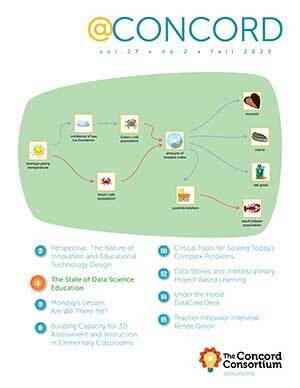Innovator Interview: Dewi Win
Q. You were at the Concord Consortium from 2004 to 2005. Tell us about that.
A. I was a math major in college and was always interested in integrating video and other technologies with education. I worked at EDC developing online professional development for math teachers. When that grant ended, I came to the Concord Consortium, where I also developed online courses for math teachers with the Seeing Math project. The courses are really powerful and include interactives, classroom video, and expert commentator video. I’m thrilled that they continue to be offered at PBS TeacherLine and Teachscape.
Q. What did you do between 2005 and 2009?
A. After Seeing Math ended, it dawned on me that it had been a while since I’d been in the classroom, since I had knowledge fresh in my head about real classroom issues, what students struggle to learn. So I went to a small teacher certif ication program based at the Parker Charter Essential School, then taught middle school math for four years.
Q. You’ve been back with the Concord Consortium since 2009. What excites you most?
A. The people, the projects, the technology we use — it’s all really exciting. My own kids have been involved in pilot tests here — my seventh grade daughter came for a three-day engineering workshop and built a model solar house. My fourth grade son tested the evolution software, which is game-like and really engaging. They both love it here. I do, too.
Q. What do you see in the future of teaching math using technology that excites you?
A. When I first taught years ago, we didn’t even have computers. Now there are so many opportunities — from SMART boards to clickers to applets available with a simple Google search. But technology comes with its costs — kids play and there’s the overhead. A carefully laid plan can fall by the wayside if the computer lab is already reserved. That’s my biggest dream for future technology use — no barriers!
Q. What do you like to do outside of work?
A. I injured myself playing tennis, so I’m looking for new sports. I’m taking a tap dancing class. My kids beat me in ping pong. And for fun I drive my kids around to their fun activities.
Q. Have you done anything particularly unusual you want to share?
A. I’ve traveled to very remote places — Machu Picchu, Irian Jaya, Iguazu Falls. I saw the Taj Mahal as a little girl. My parents were both professors, so they had summers off and we traveled all the time. I hope to visit Sulawesi soon to see an exchange student who lived with us last year. I love experiencing other cultures.
Q. Can you describe the projects you’re currently working on?
A. SmartGraphs is an integration of all the things I love — math, science, software, students, teaching. We have the ability to integrate lots of different tools in one environment. We’ve been collecting data with probes for a long time. Our software can now read that data, generate questions about the data, and evaluate whether the students’ questions are on target. I think what makes SmartGraphs so powerful is that kids can interact with the graph and they can create their own graphs. Graphs are not just presented to them. The graphs have meaning to them — they’re more alive. Students can experiment in a way that a textbook doesn’t allow. We can ask questions about the graphs and their predictions are confirmed right away. If software is engaging, it makes the experience more memorable and exciting for kids.
This material is based upon work supported by the National Science Foundation under grant DRL-0918522. Any opinions, findings, and conclusions or recommendations expressed in this material are those of the author(s) and do not necessarily reflect the views of the National Science Foundation.
